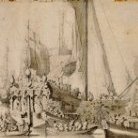Mr Waldemar makes the following statements:
A) "I still have to mention here an alternative reconstruction of the method used to design this yacht, which I nevertheless find totally implausible"
I think this statement reflects on Mr. Waldemar's ability to understand it, not on the method which is elegantly simple. In fact the most simple contemporary method that the authors of the paper are aware of.
"it is incomprehensible and it is doubtful whether it could be practically applied"
That it is incomprehensible to Mr. Waldemar suggests more of a closed mind in the commentator than in the method. It has been practically applied as demonstrated in the paper that he refers to. Both authors reconstructed the lines independently. I used ACAD and my fellow author used the traditional 17th century way of paper, pencil and cut out reconciling curves (based on the cono-cuneus geometry defined by Dr. Wallis). That Mr. Waldemar cannot see how a method derived and drawn on paper cannot be scaled up to apply on a prototype ignores the obvious truth that nearly all of the documented methods of mid to late 17th century do exactly this! i.e. draw them on paper using a mechanical process and then transfer this to the actual construction by scaling up the patterns used.
C) "the correspondence of the reconstructed lines presented in the publication with the original lines is only illusory, as I have personally verified"
You cannot verify a negative Mr. Waldemar. You may have found a method which does something similar but have not disproved the method.
D) "it is not clear why the lines conceived as curves of the least resistance should have been applied transversely to the hull"
The cono-cuneus curve was not conceived as a line of least resistance. It was conceived as a reconciling curve of the type known by us today as a 'French curve'. Peter Pett's method of arriving at it by cutting through a cono-cuneus solid was so ingenious that it amazed Dr. Wallis, one of the most eminent mathematicians of the day . . . so much so that he derived a mathematical treatise to define it. Its use in conjunction with a 'hanging conoid (as understood by Sutherland) guarantees a solid of low resistance. The author's investigated this by constructing numerous flow lines along the solid. They were all perfectly smooth - unlike earlier methods which resulted in ripples in the flow lines. The method, thus, required no fairing.
Also, might I add, that if Mr. Waldemar has found a method which apparently is not dissimilar to Sutherlands published method, why was Sutherland so impressed with Pett's method? Why did he state in his treatise that he did not know how Pett did it?
I hope the points I have made might at least support our honest attempt to resolve a previously unsolved mystery. I congratulate Mr. Waldemar on his own work. However, I would like to point out that the only methods we know to be actually true are those few published by the contemporary practitioners such as Anthony Deane and William Sutherland. We do not even know for sure if the published methods were actually used as presented on real vessels. We have no extant ships to compare against, only models. So all methods, including our C-C method, are conjectural. We have shown that this method fits some of the clues in the written literature and that it reasonable fits the shape of several yacht models.
My fellow author, and others I believe, has found the style of Mr. Waldemar's rhetoric so impolite that they have opted to withdraw from this debate. I, as the researcher who proposed this method, felt duty bound to respond on our behalf. In justification I can only point out that our paper was peer reviewed and published by the leading journal on Maritime History. We are humble enough for it to be criticised based on its content but not dismissed as illusory because Mr. Waldemar has found another method which satisfies him. If he is as confident in his research as implied by his statements, then let him go to the effort of substantiating it and getting it published it in a peer-reviewed academic journal.
I will not re-enter this debate as I fear it will once again deteriorate.
I, for one, am humbly amazed by the obvious ingenuity of those 17th century shipwrights. We follow them today 'on the shoulders of giants'.
Effie Moneypenny
